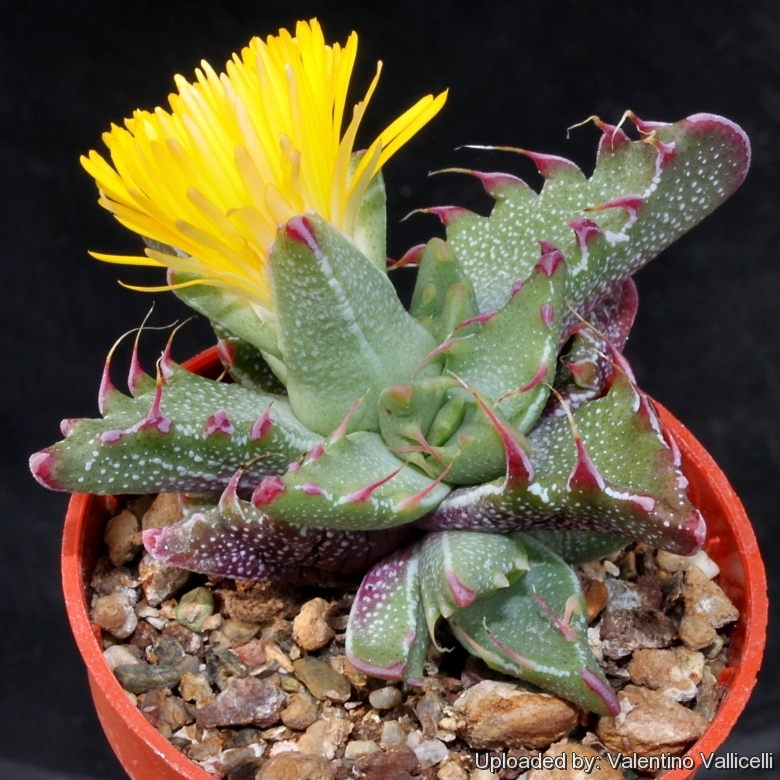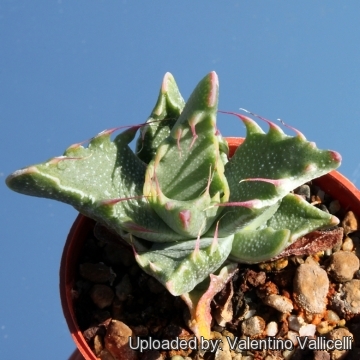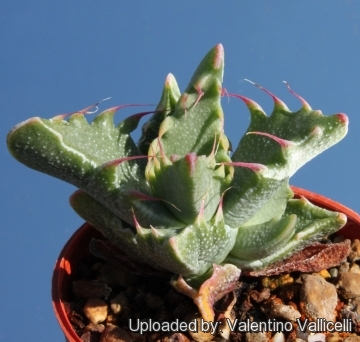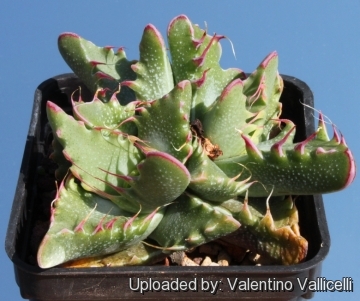Accepted Scientific Name: Faucaria tigrina (Haw.) Schwantes
Z. Sukkulentenk. ii. 177 (1926).

Faucaria tigrina Lynton, Eastern Cape, South Africa Photo by: Valentino Vallicelli
Origin and Habitat: Lynton Farm, Eastern Cape, South Africa.
Synonyms:
See all synonyms of Faucaria tigrina
back
Accepted name in llifle Database:Faucaria tigrina (Haw.) SchwantesZ. Sukkulentenk. ii. 177 (1926).Synonymy: 4
back
Description: This is a local form from Lynton Farm that distinguish from the typical species for the gorgeous leaves with bright purple marginal teeth. It is a clump-forming perennial succulent, with usually stemless rosettes, but can builds short woody stems with age.
Leaves: Thick, green triangular. Marginal teeth 3-7 (up to 10 in the standard form) pointed, recurved and purple, making it looks like open jaws. The upper surface is slightly rough with a profusion of tiny white dots upon close inspection and with a rounded interface.
Flowers: Yellow, up to 5 cm wide, attractive daisy like, appearing from the centre of the rosette.
Blooming season: Autumn to early winter. Flowers need full sun to open, open around noon and close at night.
Subspecies, varieties, forms and cultivars of plants belonging to the Faucaria tigrina group
Bibliography: Major references and further lectures
1) Heidrun E. K. Hartmann “Aizoaceae F – Z” Springer, 2002
2) James Cullen, Sabina G. Knees, H. Suzanne Cubey “The European Garden Flora Flowering Plants: A Manual for the Identification of Plants Cultivated in Europe, Both Out-of-Doors and Under Glass - Casuarinaceae to Aristolochiaceae” Cambridge University Press, 11/ago/2011
3) Hermann Jacobsen, Vera Higgins “Succulent Plants: Description, Cultivation and Uses of Succulent Plants, Other Than Cacti” Williams and Norgate, Limited, 1935
4) Jacobsen. “Handbook of succulent plants” 1328 (1960)
5) H. Herre “The genera of the Mesembryanthemaceae” Tafelberg-Uitgewers Beperk, 1971
 - (MG1244) Lynton Farm, Eastern Cape, South Africa. Photo by: Valentino Vallicelli
- (MG1244) Lynton Farm, Eastern Cape, South Africa. Photo by: Valentino Vallicelli Faucaria tigrina Lynton, Eastern Cape, South Africa Photo by: Valentino Vallicelli
Faucaria tigrina Lynton, Eastern Cape, South Africa Photo by: Valentino Vallicelli Faucaria tigrina Lynton, Eastern Cape, South Africa Photo by: Valentino Vallicelli
Faucaria tigrina Lynton, Eastern Cape, South Africa Photo by: Valentino Vallicelli Faucaria tigrina Lynton, Eastern Cape, South Africa Photo by: Valentino Vallicelli
Faucaria tigrina Lynton, Eastern Cape, South Africa Photo by: Valentino VallicelliCultivation and Propagation: The plants in this genus represent some of the more easily cultivated succulent species. These plants grow on winter rain and were heading for spring-summer dormancy. Requires little water otherwise their epidermis breaks (resulting in unsightly scars). Water moderately from the middle of summer to the end of winter, and keep the compost almost dry when the plants are dormant. Water minimally in spring and summer, only when the plant starts shrivelling, but they will generally grow even in summer if given water. In areas prone to frost, grow in an intermediate greenhouse or conservatory, in pots of cactus compost, obtainable from good garden centres. Keep cool and shaded in summer, but provide maximum light the rest of the year.
Propagation: Seeds or division of larger clumps.














